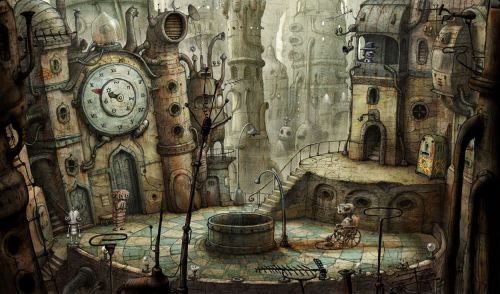Trending
Opinion: How will Project 2025 impact game developers?
The Heritage Foundation's manifesto for the possible next administration could do great harm to many, including large portions of the game development community.

Featured Blog | This community-written post highlights the best of what the game industry has to offer. Read more like it on the Game Developer Blogs or learn how to Submit Your Own Blog Post
What makes a bad gimmick? This article was inspired by Craig Stern's previous entry, noting the over-importance placed on a screen-shot and aesthetics throughout the indie game scene. Is it avoidable? Is it really a bad thing? What are the alternatives?


With marginal budgets and negligible development time, indie game developers can find it quite hard to manage a proper marketing campaign. They commonly rely on blogs and gaming sites for their main publicity.
This requires indie games to generate news, for which developers often resort to gimmicks or hooks. But focusing on a gimmick can belie the real experience that players can expect from the game.
Using hooks to lure in potential customers is certainly not specific of the indie game scene; it's not even specific to the entertainment industry. Much bigger titles such as Bioshock 2 also resort to gimmicky, referred to as viral in internet terms, advertisement. Yet their diverse marketing strategies are separate from the game itself. When a sidewalk painter creates a mural or someone tells a bedtime story based on the game, it doesn't affect the gameplay in any way. But with scarcely enough time and money to complete production, indie game developers often have found that the game must primarily market itself.
In a Gamasutra blog, Craig Stern has recently noted that there is an unhealthy obsession on screenshots and aesthetics spreading across the indie scene. But while it may be unfair to judge an entire game on a single screenshot, that may be the cold reality of today's fast-paced market. Just as scripts and stories are often tossed or kept after reading the first paragraph, games must also make a good impression.
Machinarium: The Good Hook
I recently played a demo of Machinarium, which is a fairly typical, albeit quirky, 2D point-and-click adventure. Would I have given the game a chance if it didn't boast such a unique and whimsical art style? I would like very much to say that I would have, but it's more likely that I wouldn't even be aware of its existence, much less have taken the time to try it. I was, in fact, hooked into playing the game with a screenshot.

machinarium_04_bigger
But are Machinarium's graphics simply a ploy designed to attract players? Only if you're willing to label any and every art style as such. Machinarium's graphics work very well with its sound design and gameplay, making it part of the complete experience.
This highlights a very important point: not every hook is a bad hook. There are many times in which a developer's need to differentiate themselves from the crowd will encourage them to create a higher quality and more original product. Such is the case with Machinarium.
The Bad Hook
So then which hooks are in bad form, as Captain Hook would say? While good hooks arise as a byproduct of high quality work, bad hooks do not. They are often gratuitous and can even cripple a game. The question that developers should ask themselves is: Am I including this gimmick because I think it will result in an overall better experience for the player, or am I including it to make an easy headline?
A good gimmick can set the game apart from the rest, but one who's purpose is simply to set the game apart can ultimately cripple the game's chance at success. Even Jonathan Blow, creator of Braid, has said that he's found himself "not wanting to play unthoughtful indie gimmicks." He stresses, however, the adjective "unthoughtful," as not every gimmick is a bad gimmick.
Herein a difficult judgment call must be made between valuable novelty and flippant novelty. There may be a certain allure to creating the "first game to do..." or the "first game to have..." but often times things exist as they are for a reason -- it's what works best. Is incorporating a scanner, a webcam, and a printer into your game's design really going to benefit the player? Perhaps it would and perhaps it won't, but it's sure to generate news.
Then, of course, there are hooks which are easier to label as objectively bad -- such as if a developer were to purchase a waterproof laptop and develop the whole game underwater just to create buzz. Creating games with controversial topics or content without the proper substance to achieve legitimacy can also fall into this category.
Who's to Blame?
Developers cannot be blamed for trying to come up with creative ways for their game to see some publicity. And for an indie game, no news is most certainly not good news.
Consumers cannot be blamed for trying a game because it looks nice, as there may be nothing else on which to base their initial opinions and they can't be forced to try every game made.
The responsibility of distinguishing good hooks from bad ones, and indeed, good games from bad games, falls upon the shoulders of the people writing the headlines, not making them. It's quite easy to report on a game with a gimmick, you rarely even have to play the game. A headline such as "New Indie Game to be Controlled by a Pair of Fuzzy Dice," is more quickly and easily written than, "New Indie Game is Good for the Following Reasons."
The Trouble with Gameplay
But let's assume that journalists are committed to bringing us what they consider will be the best of games, and not to succumb to the easy story. We're still left with one very big problem. The best of games are usually famous for great gameplay, and while screenshots and gimmicks can be sent in press releases several months in advance, gameplay requires a nearly finished product to test.
How should a developer focusing on quality gameplay without the benefit of gimmicks attempt to generate news? They can't send journalists a press release that reads, "Trust me the game is gonna be really good."
Lookie, Lookie, I got Hookie
To solve this problem, I suggest a strangely under-used strategy in the current market. There are plenty of interviews and articles that highlight games' features in very broad terms, but few that attempt much detail. Just as a screenshot encapsulates a single image from the game, a short video can explain a single aspect of gameplay which defines the game.
Let's say a hypothetical RPG is trying to generate news by claiming that they will feature rogues as one of their classes in the game. That's not very thrilling news. However, if instead of simply stating that they will have rogues they focus on a feature of their stealth system, it might be newsworthy. For instance, most MMORPGs stealth systems allow players to disappear entirely and walk across barren plains in broad daylight undetected unless they come too close to an opponent. If instead an MMO decided to implement a stealth system by giving players a host of lesser abilities they can use to conceal or disguise themselves, it would be a newsworthy facet of the game.
In short, developers would have to -- as they currently do -- convince journalists that their game is worth covering. And journalists would have to be more sensitive to this type of news. This is not to imply that they'd have to fawn over every bit of gameplay that's sent their way. The ensuing article could very well call into question how effective the stealth system in the previous example would actually be. The important thing is that we move beyond the simple screenshot or cockamamie gimmick.
Why any of this Matters
This article is written primarily in defense of more traditional indie games. In most disciplines, elegantly adhering to the standards of the craft is to be lauded, and in fact many of the games that do are quite successful. But an indie game that wishes to refine existing conventions rather than reinvent them may find it difficult to garner much attention.
It would be nice if game journalists could provide an infinite amount of coverage, spanning all games and all viewpoints. And it would be nice if readers had the time and patience to read them all, but such is not the case. Both are in limited amounts.
Even if every game were to receive equal coverage, it would result in either very sparse articles and information or a flood of articles that would see a headline swept off the front page before you could finish reading it. Time and exclusivity is required for an article's exposure to be effective. And so, good choices must be made, or the game that someone programmed upside-down in three hours may take the limelight, while dozens of more deserving games must dwell in the shadows.
Read more about:
Featured BlogsYou May Also Like